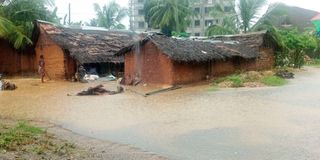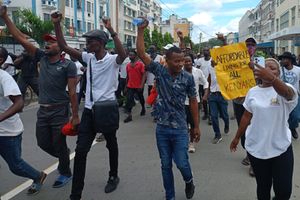Happening now: Liveblog: Kenyan youth stage #OccupyEverywhere protests
Measures that Kenya should take to end perennial floods

Even worse, heavy rains are triggering disastrous mudslides that sweep away people, bridges, roads and entire buildings.
What you need to know:
- The situation is worsened by the climate crisis occasioned by human activities.
- Storms and cyclones like Hidaya have ripped through the region, leaving behind a trail of destruction.
Floods have killed hundreds of people, washed away crops and destroyed property worth millions of shillings. Approximately 300 people have lost their lives while another 300,000 have been affected by the recent floods.
In Eastern Africa, over 600,000 people have been affected, with 234,000 forced from their homes, and the numbers continue to rise, according to the UN Office for Coordination of Humanitarian Affairs.
The perennial cycle of floods and drought has been identified as one of the major climate disasters occurring in Kenya.
The situation is worsened by the climate crisis occasioned by human activities. Storms and cyclones like Hidaya have ripped through the region, leaving behind a trail of destruction.
We are also seeing impacts like drought that are causing food shortages and water scarcity. The climate crisis is no longer imminent — it is claiming lives and it will only get worse unless we take action.
According to Yale Climate Connections, over the past two years, Africa has experienced five of its top 30 deadliest extreme weather disasters since record-keeping began in 1900. The science is clear: we are in a climate emergency. There is nothing natural about the devastating floods that occurred in Kenya recently.
Even worse, heavy rains are triggering disastrous mudslides that sweep away people, bridges, roads and entire buildings. Due to the climate crisis, we are seeing more and more extreme weather events at scales we have never experienced before and that we are not prepared for.
Real action
Unfortunately, this will not be the last extreme weather event that Kenya and other countries will face. This then calls for disaster preparedness.
President William Ruto has declared two national holidays dedicated to planting trees across the nation. However, planting trees in the middle of devastating floods and drought won’t cut it. We need real action; not false solutions such as carbon offsetting projects. Carbon offsetting projects are little more than a licence for the Global North and big polluters to keep polluting.
It doesn’t make sense for Kenya to sell off land for tree planting projects that have been riddled with scandals and faced and criticism from climate scientists.
Without doubt, there is a growing need to address the climate crisis and find a lasting solution to the perennial flooding. Now more than ever, we need bold action from President Ruto’s government to ensure that the following demands are acted upon.
● The government must ensure that disaster management funds are channelled to communities that have been impacted heavily by the devastating floods. Our leaders must provide immediate aid to those affected instead of destroying their homes – they should consult, resettle and fulfil any promises made to support the flood victims.
● Fossil fuels should be phased out by 2030. Fossil fuel companies should be held accountable and contribute their fair financial share in addressing the climate crisis.
● Kenya should transition to efficient and renewable energy sources like solar and wind. This will help create green and sustainable jobs and safeguard our planet.
● The government should embrace and invest in agroecological farming techniques that promote biodiversity, soil health and water conservation. This will help mitigate the impacts of extreme weather events and ensure food security.
The government needs to push for the ‘polluter pays’ system that will hold companies and countries that are profiting from destruction accountable, and channel those funds directly to support communities suffering the worst impacts of floods.
As the head of the Committee of African Heads of States and Governments on Climate Change, President Ruto should shift his attention away from promoting unsustainable and false solutions such as carbon offsetting projects and champion real solutions to the climate crisis such as financing investments in clean and renewable energy systems, fixing agricultural systems and protecting our biodiversity
Ms Dena is the project lead at Greenpeace Africa


